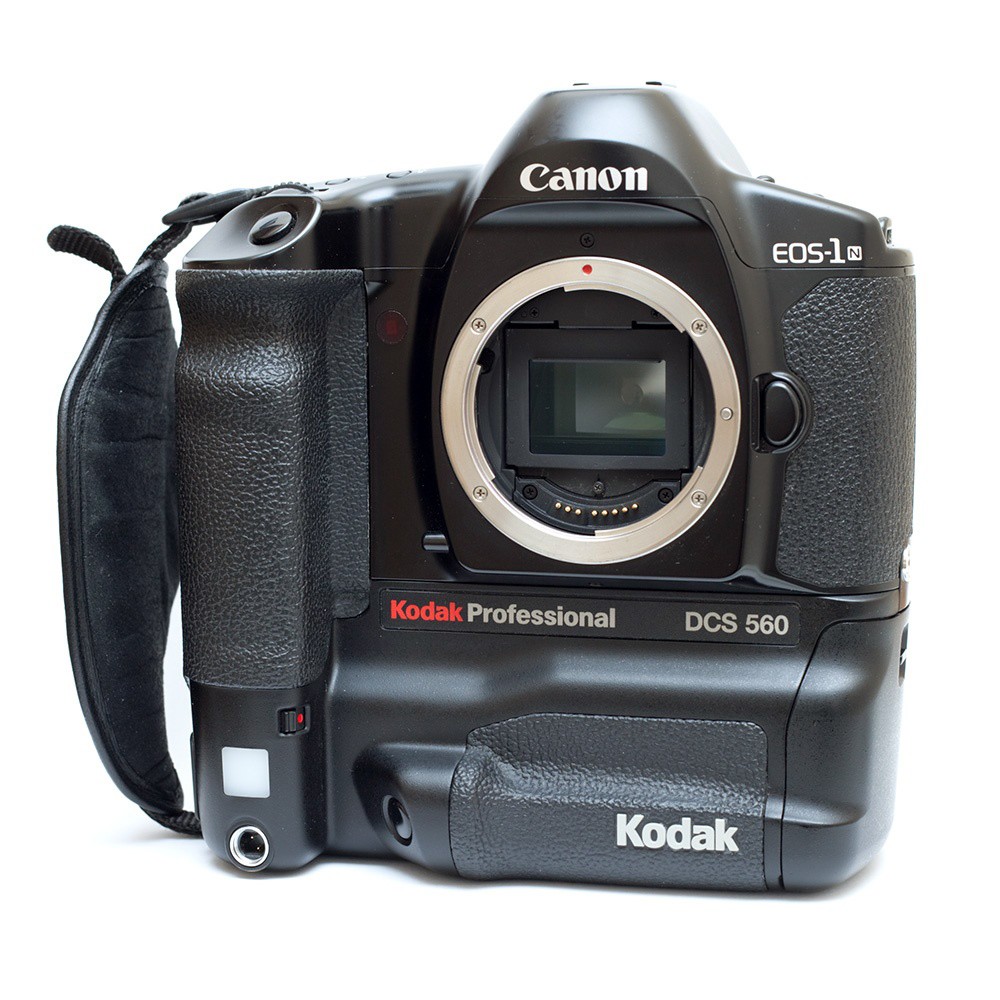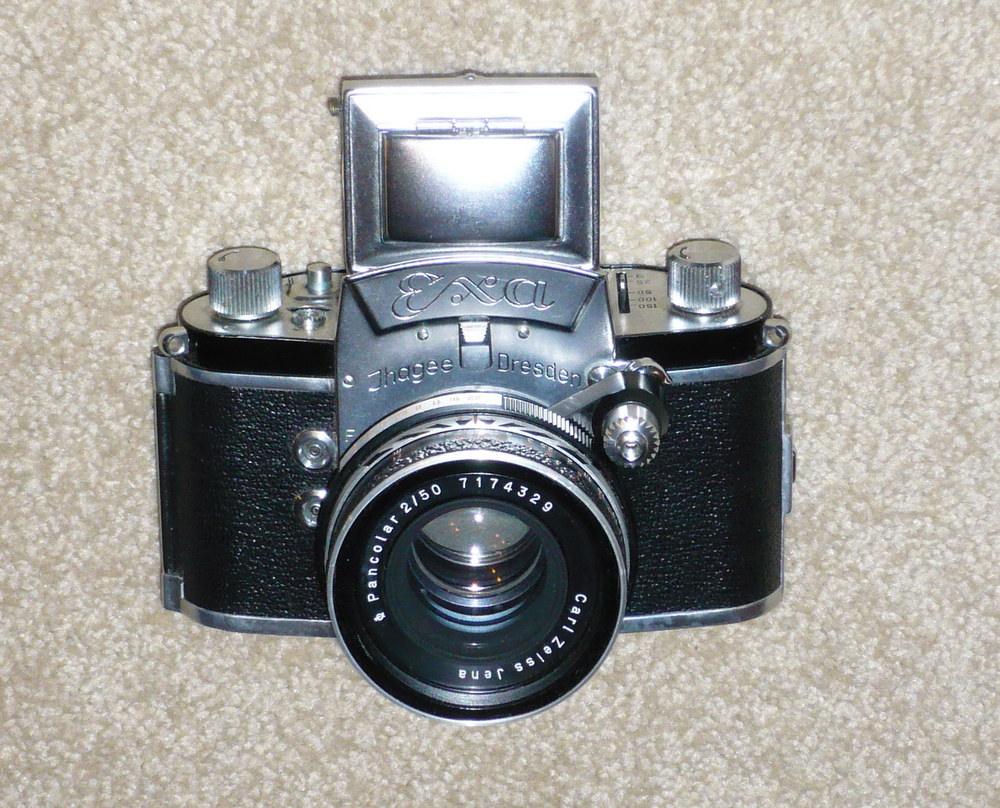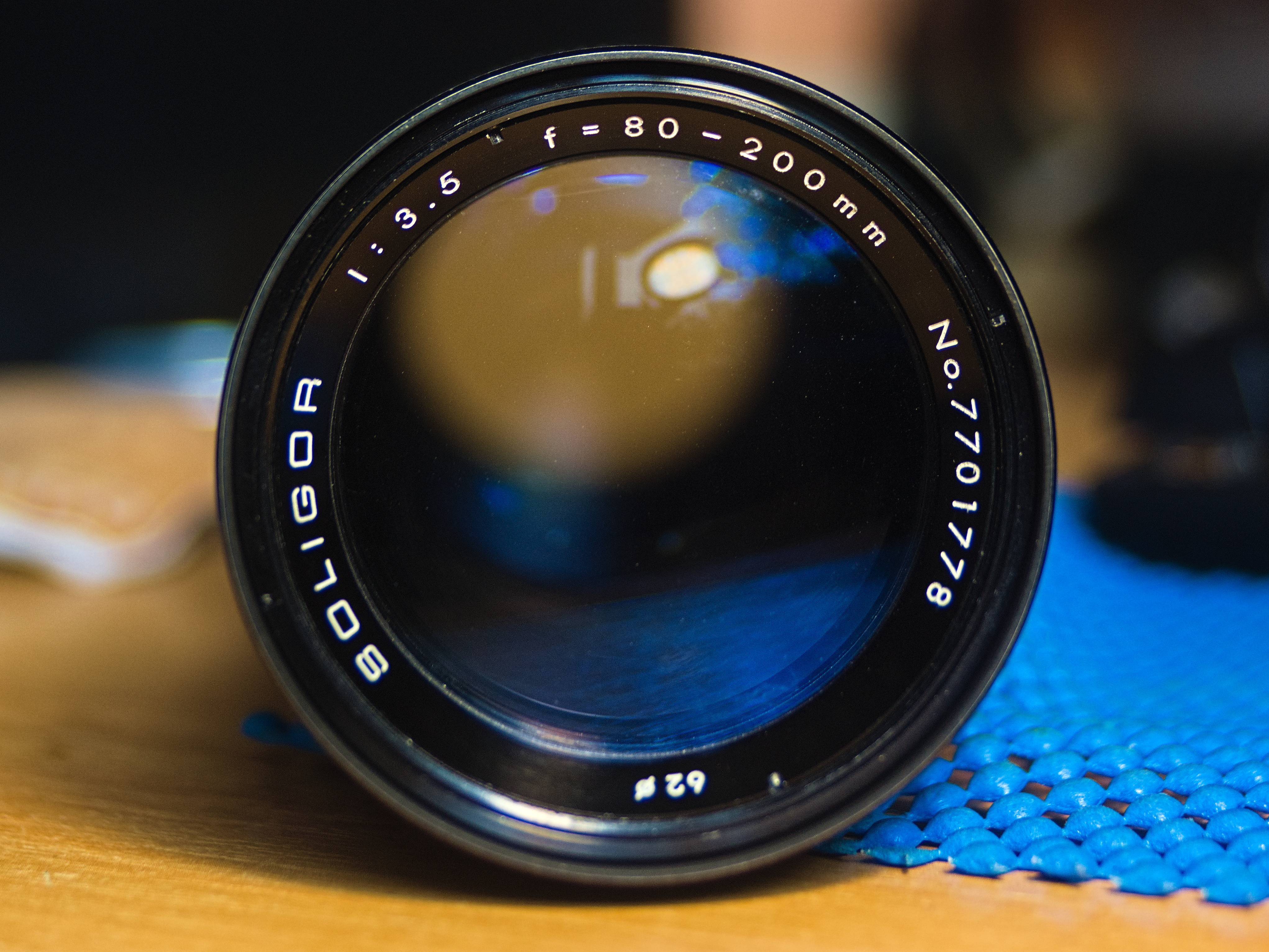|
Canon EOS-1
The EOS-1 is a 35mm single lens reflex (SLR) camera body produced by Canon. It was announced by Canon in 1989, and was the professional model in the range. The camera also had a successor, the Canon EOS-1N, in 1994. The original EOS-1 was launched in 1989. It was the company's first professional-level EOS camera and was aimed at the same photographers who had used Canon's highly respected, manual focus professional FD mount SLRs, such as the Canon New F-1 and the Canon T90. On a physical level the EOS-1 resembled the T90, which had been designed for Canon by Luigi Colani. The EOS-1 had a single centrally mounted autofocus point, plus basic weather sealing. Features At the time of its creation, The Canon EOS-1 was placed at the top of Canon's EOS camera line. The camera featured a plastic shell (polycarbonate Polycarbonates (PC) are a group of thermoplastic polymers containing carbonate ester, carbonate groups in their chemical structures. Polycarbonates used in engineering ... [...More Info...] [...Related Items...] OR: [Wikipedia] [Google] [Baidu] |
Canon (company)
Canon Inc. (; Hepburn romanization, Hepburn: ) is a Japanese multinational corporation headquartered in Ōta, Tokyo, Ōta, Tokyo, specializing in optical, imaging, and industrial products, such as lenses, cameras, medical equipment, Image scanner, scanners, Printer (computing), printers, and Semiconductor device fabrication, semiconductor manufacturing equipment. Canon has a primary listing on the Tokyo Stock Exchange and is a constituent of the TOPIX Core 30 and Nikkei 225 indexes. It used to have a secondary listing on the New York Stock Exchange. Name The company was originally named (). In 1934, it produced the ''Kwanon'', a prototype for Japan's first-ever 35mm camera with a focal-plane-based shutter. In 1947, the company name was changed to ''Canon Camera Co., Inc.'', shortened to ''Canon Inc.'' in 1969. The name Canon comes from Buddhist bodhisattva (), previously transliterated as Kuanyin, Kwannon, or Kwanon in English. History 1933–1970 The origins of Canon date ba ... [...More Info...] [...Related Items...] OR: [Wikipedia] [Google] [Baidu] |
Canon EF Lens Mount
The EF lens mount is the standard lens mount on the Canon EOS family of SLR film and digital cameras. EF stands for "Electro-Focus": automatic focusing on EF lenses is handled by a dedicated electric motor built into the lens. Mechanically, it is a Bayonet mount, bayonet-style mount, and all communication between camera and lens takes place through electrical contacts; there are no mechanical levers or plungers. The mount was first introduced in 1987. Canon claims to have produced its 100-millionth EF-series interchangeable lens on April 22, 2014. History The EF mount replaces its predecessor, the Canon FD, FD mount. The standard autofocus lens mounting technology of the time used a motor in the camera body to drive the mechanics of the focus helicoid in the lens by using a transfer lever. The key innovation of the EF series was to use a motor inside the lens itself for focusing. This allowed for autofocusing lenses which did not require mechanical levers in the mount mechani ... [...More Info...] [...Related Items...] OR: [Wikipedia] [Google] [Baidu] |
Autofocus
An autofocus (AF) optical system uses a sensor, a control system and a motor to focus on an automatically or manually selected point or area. An electronic rangefinder has a display instead of the motor; the adjustment of the optical system has to be done manually until indication. Autofocus methods are distinguished as active, passive or hybrid types. Autofocus systems rely on one or more sensors to determine correct focus. Some AF systems rely on a single sensor, while others use an array of sensors. Most modern SLR cameras use through-the-lens optical sensors, with a separate sensor array providing light metering, although the latter can be programmed to prioritize its metering to the same area as one or more of the AF sensors. Through-the-lens optical autofocusing is usually speedier and more precise than manual focus with an ordinary viewfinder, although more precise manual focus can be achieved with special accessories such as focusing magnifiers. Autofocus accur ... [...More Info...] [...Related Items...] OR: [Wikipedia] [Google] [Baidu] |
Canon EOS-1N
The EOS-1N is a 35mm single lens reflex (SLR) camera body produced by Canon Inc., Canon. It was announced by Canon in 1994, and was the professional model in the range, superseding the original Canon EOS-1. The camera was itself superseded by the Canon EOS-1V, EOS-1V in 2000. The original EOS-1 had been launched in 1989, two years after the company had introduced their new Canon EOS, EOS autofocus system. It was the company's first professional-level EOS camera and was aimed at the same photographers who had used Canon's highly regarded, manual focus professional Canon FD lens mount, FD mount SLRs, such as the Canon New F-1 and the Canon T90. On a physical level the EOS-1 resembled the T90, which had been designed for Canon by Luigi Colani. The EOS-1N was a revision of the EOS-1, with five autofocus points spread across the frame rather than a single centrally-mounted autofocus point, plus more effective weather sealing, a wider exposure range, and numerous other improvements. In c ... [...More Info...] [...Related Items...] OR: [Wikipedia] [Google] [Baidu] |
35mm Format
file:135film.jpg, 135 film. The film is wide. Each image is 24×36 mm in the most common "small film" format (sometimes called "double-frame" for its relationship to the "single-frame" 35 mm movie format or full frame after the introduction of 135 sized digital sensors; confusingly, "full frame" was also used to describe the Full frame (cinematography), full gate of the movie format half the size). file:LEI0060 186 Leica I Sn.5193 1927 Originalzustand Front-2 FS-15.jpg, Leica I, 1927, the first successful camera worldwide for 35 cine film 135 film, more popularly referred to as 35 mm film or 35 mm, is a Film format#Still photography film formats, format of photographic film with a film gauge of loaded into a standardized type of magazine (also referred to as a cassette or cartridge) for use in 135 film cameras. The term 135 was introduced by Kodak in 1934 as a designation for 35 mm film specifically for still photography, perforated with Film perforation ... [...More Info...] [...Related Items...] OR: [Wikipedia] [Google] [Baidu] |
Single Lens Reflex
In photography, a single-lens reflex camera (SLR) is a type of camera that uses a mirror and prism system to allow photographers to view through the lens and see exactly what will be captured. SLRs became the dominant design for professional and consumer-level cameras throughout the late 20th century, offering interchangeable lenses, through-the-lens (TTL) metering, and precise framing. Originating in the 1930s and popularized in the 1960s and 70s, SLR technology played a crucial role in the evolution of modern photography. Although digital single-lens reflex (DSLR) cameras succeeded film-based models, the rise of mirrorless cameras in the 2010s has led to a decline in SLR use and production. With twin lens reflex and rangefinder cameras, the viewed image could be significantly different from the final image. When the shutter button is pressed on most SLRs, the mirror flips out of the light path and allows light to pass through to the light receptor and the image to be captured. ... [...More Info...] [...Related Items...] OR: [Wikipedia] [Google] [Baidu] |
Canon Inc
Canon Inc. (; Hepburn: ) is a Japanese multinational corporation headquartered in Ōta, Tokyo, specializing in optical, imaging, and industrial products, such as lenses, cameras, medical equipment, scanners, printers, and semiconductor manufacturing equipment. Canon has a primary listing on the Tokyo Stock Exchange and is a constituent of the TOPIX Core 30 and Nikkei 225 indexes. It used to have a secondary listing on the New York Stock Exchange. Name The company was originally named (). In 1934, it produced the ''Kwanon'', a prototype for Japan's first-ever 35mm camera with a focal-plane-based shutter. In 1947, the company name was changed to ''Canon Camera Co., Inc.'', shortened to ''Canon Inc.'' in 1969. The name Canon comes from Buddhist bodhisattva (), previously transliterated as Kuanyin, Kwannon, or Kwanon in English. History 1933–1970 The origins of Canon date back to the founding of Precision Optical Instruments Laboratory in Japan in 1933 by Takeshi Mitarai, ... [...More Info...] [...Related Items...] OR: [Wikipedia] [Google] [Baidu] |
Canon FD Lens Mount
The Canon FD lens mount is a physical standard for connecting a photographic lens to a 35mm single-lens reflex camera body. The standard was developed by Canon (company), Canon of Japan and was introduced in March 1971 with the Canon F-1 camera. It served as the Canon SLR interchangeable lens mounting system until the 1987 introduction of the Canon EOS series cameras, which use the newer Canon EF lens mount, EF lens mount. The FD mount lingered through the release of the 1990 Canon T60, the last camera introduced in the FD system, and the end of the Canon New F-1 product cycle in 1992. Overview The FD mount is mechanically compatible with and replaced Canon's earlier Canon FL, FL mount,which in turn had replaced the Canon R lens mount, R mount; FD-mount cameras can use FL lenses in Stopping down, stop-down metering mode and R lenses will mount, but must be used with manual aperture and stop-down metering. Though never officially explained by Canon, others have attempted to assi ... [...More Info...] [...Related Items...] OR: [Wikipedia] [Google] [Baidu] |
Canon New F-1
The Canon New F-1 is a professional 135 film, 35 mm single-lens reflex camera that replaced the Canon F-1n, F-1n (an upgraded Canon F-1, F-1) as Canon Inc., Canon's top-of-the-line 135 film, 35mm single-lens reflex camera in September 1981. Like the earlier models, the New F-1 takes Canon FD, FD-mount lenses. Although no date has ever been confirmed, it is thought that the last New F-1 was made in 1992. It was officially discontinued in 1994, and factory support ended in 2004. Overview The New F-1 is a manual-exposure camera capable of TTL full-aperture metering and stopped-down metering with the included Eye-Level Finder FN using a match-needle metering system. Aperture priority autoexposure is available by attaching the optional AE Finder FN. Also, shutter priority mode is optionally available when using either AE Motor Drive FN or AE Power Winder FN. The New F-1 is also capable of operating in aperture priority mode with earlier Canon lenses which do not have an automatic ... [...More Info...] [...Related Items...] OR: [Wikipedia] [Google] [Baidu] |
Canon T90
The Canon T90, introduced in 1986, was the top of the line in Canon's '' T series'' of 35 mm Single-lens reflex (SLR) cameras. It is the last professional-level manual-focus camera from Canon, and the last professional camera to use the Canon FD lens mount. Although it was overtaken by the autofocus revolution and Canon's new, incompatible EOS (Electro-Optical System) after only a year in production, the T90 pioneered many concepts seen in high-end Canon cameras up to the present day, particularly the user interface, industrial design, and the high level of automation. Due to its ruggedness, the T90 was nicknamed "the tank" by Japanese photojournalists. Many have still rated it highly even 30+ years after its introduction. Design Previous Canon cameras had been wholly in-house design projects. For the T90, Canon brought in German industrial designer Luigi Colani in a collaboration with Canon's own designers. The final design was composed of Colani's ideas by Kunihisa It ... [...More Info...] [...Related Items...] OR: [Wikipedia] [Google] [Baidu] |
Luigi Colani
Luigi Colani (born Lutz Colani; 2 August 1928 – 16 September 2019) was a German industrial designer. His long career began in the 1950s when he designed cars for companies including Fiat, Alfa Romeo, Lancia, Volkswagen, and BMW. In 1957, he dropped his first name ''Lutz'' using the name ''Luigi''. In the 1960s, he began designing furniture, and as of the 1970s, he expanded in numerous areas, ranging from household items such as ballpoint pens and television sets to uniforms and trucks and entire kitchens. A striking grand piano created by Colani, the ''Pegasus'', is manufactured and sold by the Wilhelm Schimmel, Schimmel piano company. His unconventional designs made him famous, not only in design circles, but also to the general public. He received numerous design awards, although his unconventional approach left him largely an outsider from the mainstream of industrial design. Style The prime characteristic of his designs are the rounded, organic forms, which he terms "bi ... [...More Info...] [...Related Items...] OR: [Wikipedia] [Google] [Baidu] |
Canon EOS 1 Kpl
Canon or Canons may refer to: Arts and entertainment * Canon (fiction), the material accepted as officially written by an author or an ascribed author * Literary canon, an accepted body of works considered as high culture ** Western canon, the body of high culture literature, music, philosophy, and works of art that is highly valued in the West * Canon of proportions, a formally codified set of criteria deemed mandatory for a particular artistic style of figurative art * Canon (music), a type of composition * Canon (hymnography), a type of hymn used in Eastern Orthodox Christianity. * ''Canon'' (album), a 2007 album by Ani DiFranco * ''Canon'' (film), a 1964 Canadian animated short * ''Canon'' (manga), by Nikki * Canonical plays of William Shakespeare * ''The Canon'' (Natalie Angier book), a 2007 science book by Natalie Angier * ''The Canon'' (podcast), concerning film Brands and enterprises * Canon Inc., a Japanese imaging and optical products corporation * Château ... [...More Info...] [...Related Items...] OR: [Wikipedia] [Google] [Baidu] |






